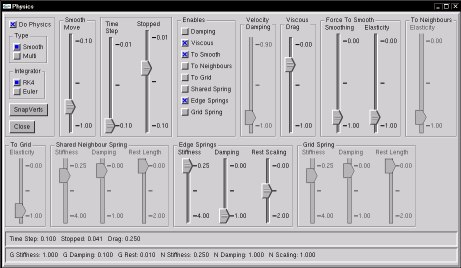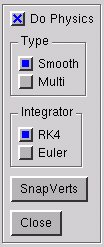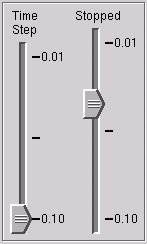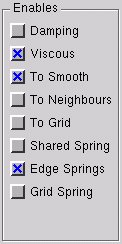|
|
|
The Physics Dialogue:

|
Misc Controls
|

|
- Physics: Enable or disable physics.
- Type: Choose the type of physics. The options are smoothing (not realy physics
at all) or multi (multiple forces act on each mesh vertex, the forces having their
own sets of controls).
- Integrator: Either a fourth-order Runge-Kutta or a simple Euler integrator can
be used for the 'multi' physics type.
- Snap Verts: Move every vert in the entire model to it's grid position and zero it's
velocity. You might want to do this if you get the simulation to explode or
if you tweak the parameters of some of the forces and want to see how they act
on the default state.
- Close: Close the window. Note that the close icon in the top-right corner of the window
will shut down the whole program.
|
|
|
Smoothing
|

|
- Move: How far along the line from a vert's grid position to the dynamicaly
calculated smooth position to generate a new position at each simulation step.
|
|
|
Multi Basic Controls
|

|
- Time Step: The simulation runs at a fixed time-step. It would only be necessary to reduce the step-size in order to avoid an explosion but it might be of interest to see the mesh deform in slow-motion.
- Stopped: The simulation is disabled once the x, y, and z componants of a group of verts' velocities fall below this value.
Increase it to make the meshes static faster.
Decrease it to get more accurate results.
|
|
|
Multi Options
|

|
- Damping: Enable the scaling of vert velocities. This drains energy from the system at every step.
- Viscous: Enable a viscous drag force.
Viscous drag opposes a vert's velocity and so acts to settle the system down.
- To Smooth: Enable a force pushing a vert towards a smoothed position calculated in the same way as the smooth physics option.
- To Neighbours: Enable forces that depend on a vert's displacement from it's resting offset from it's neighbours.
This force resists deformation and rotation but allows a mesh to translate freely.
- To Grid: Enable a force pushing a vert towards it's grid position.
This anchors a vert, stopping it from wandering too far from it's grid position under the influence of other forces.
It is also cheaper to calculate than a spring from the vert to it's grid position.
- Shared Spring: Enable a force resulting from a spring stretched between a vert and the average position of it's neighbours.
- Edge Springs: Enable a spring for each edge of the tesselation.
These springs help to resist faces collapsing or expanding far from their default sizes.
By scaling the resting length of these springs down, a mesh can be made smoother.
By scaling their resting lenghts up, it can be made crinkly.
- Grid Spring: Enable a force resulting from a spring stretched between a vert and it's grid position.
This keeps the vert from wandering from it's grid position like the directly generated To Grid force above.
Cavernosa release 0.2.0 used 2 springs; one from a vert to it's grid position
and the other to the average of it's neighbours' positions.
|
|
|
!!! Under Construction !!!
|
|
|
|
|
Options to Try with the Physics Dialogue in Multi Mode
One thing that is interesting to see is the mesh bouncing. To make a mesh bounce,
turn the viscous drag down and disable all forces other than it and edge springs which should
have their resting lengths scaled to near zero. When the mesh is wound up like
a crisp packet in a fire, turn on the To Grid force or the grid springs and watch
the mesh go. Turn the grid force off and let the mesh contract. Turn it back on and
watch it go again. Turn it off...
|





